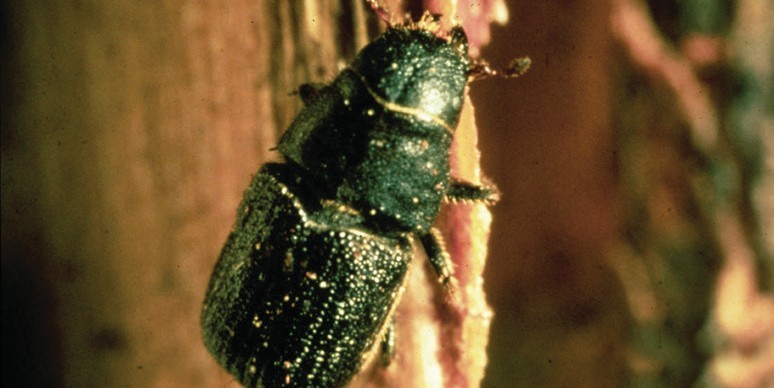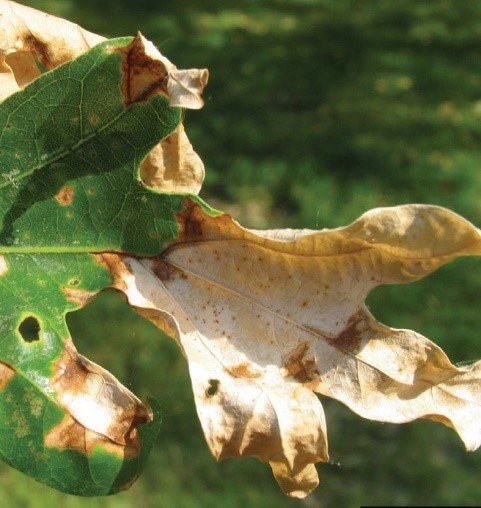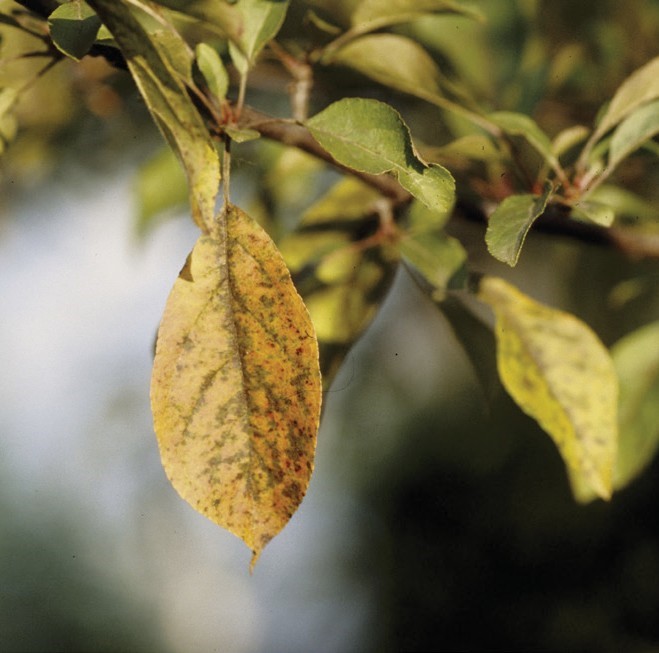If you missed the latest Fall Treatment Webinar here are some of the disease and insect related highlights that were discussed; Pine Bark Beetle, Emerald Ash Borer, Anthracnose, and Apple Scab. Read below, to find out more on how you can identify the symptoms and what we recommend for treatment….
Pine Bark Beetle

What is the threat: Several species of bark beetle (Dendroctonus) including Southern Pine Beetle, Black Turpentine Beetle, Mountain Pine beetle, Western Pine Beetle and Ips Engraver Beetles are known to attack and kill pines. These beetles bore into the tree’s cambium in large groups and disrupt nutrient and water movement, thus killing the tree. Several of these species also introduce a fungus, known as blue stain, which may kill a tree by clogging its vascular system.
Where is the threat: Some bark beetles occur nationwide, while the Mountain and Western Pine Beetles appear west of the Rocky Mountains. The Southern Pine Beetle originated in the southeastern United States, but is now found as far north as New York and as far west as Texas.
Symptoms: Most of these beetles will attack both stressed and healthy pines. Cream to red colored pitch tubes will be present in the lower bole of the tree. Crowns of individually attacked trees will fade from green to yellow to red, followed by tree death over several weeks. Most of these beetles carry a fungus that serves as a food base for young larvae. The introduced fungus then adds to inhibited water transport ability and hastens tree mortality.
What to do about it: A trunk injection of TREE-äge® R10 or TREE-äge® G4 will provide up to two years of protection from bark beetle damage. Preventive treatment is best, as trees with existing beetle infestations are unlikely to survive. In areas where beetles carry the blue stain fungus, it is recommended that a systemic fungicide such as Propizol® be added as a sequential treatment to eliminate additional stress from the fungus
Emerald Ash Borer

What is the threat: The Emerald Ash Borer (Agrilusplanipennis), or EAB, is an invasive wood boring beetle that was first introduced from Asia to Detroit, Michigan in 2002 and is known to have spread to 36 states and four provinces. This small, metallic green wood-boring beetle attacks multiple ash species and can go unnoticed for several years. The larvae live under the bark of the tree and feed on the vascular cambium through the fall and winter. The feeding produce long serpentine galleries that can girdle branches and the main stem and lead to tree mortality.
Where is the threat: EAB infests all ash species, but most commonly attack green, white and black ash. Initial infestations were documented in Michigan and Ontario Canada. Populations continued to spread throughout the Midwest and Canada. In 2013, EAB eventually found its way to New England, Georgia, and Colorado. By 2019, infestations have been confirmed from Texas and South Dakota, to Nova Scotia, Canada.
Symptoms: EAB larvae live under the bark and create meandering galleries through the phloem, cambium and the xylem layers, effectively girdling the tree. In response to upper canopy dieback, trees will sprout new (epicormic) branches in the lower crown. Adults create D-shaped exit holes when they emerge in June. Bark cracks that reveal larval galleries and woodpecker activity are also signs of EAB infestation. Since EAB often goes unnoticed for several years, trees may die within two years of the onset of symptoms.
What to do about it: For best outcomes, Arborjet recommends treatment of trees that still appear healthy (dieback symptoms <40%) when EAB is detected in your area. Our most effective solutions include two emamectin benzoate products, TREE-äge R10 and TREE-äge G4 . Both products can be applied anytime there is good soil moisture, usually June through September. In dry conditions, a follow up application of NutriRoot® could improve tree health. IMA-jet® provides annual control and may be preferred when piercing, sucking insects are present.
Anthracnose

What is the threat: Anthracnose is a fungus that winters on twig tissue and causes leaf spots. The most common species of anthracnose are the Apiognomonia and Discula: two destructive fungi which cause additional twig and limb dieback. They both survive on dead twigs and buds, infecting newly emerged leaves in cool wet spring conditions. The fungi kill the leaf and grow down through the petiole to attack the twigs. Severe infections lead to twig and branch die back.
Where is the threat: Sycamores are most susceptible to Apiognomonia while dogwoods are more susceptible to Discula. Infection of Pacific dogwood has been reported in Washington, Oregon, Idaho and British Columbia, while flowering dogwoods in the east are susceptible from Massachusetts to Georgia. American and California sycamores are frequently infected while improved cultivars, such as the London Plane, are somewhat resistant.
Symptoms: Sycamore anthracnose symptoms include blotchy, irregular lesions that lead to shoot dieback and blighted areas. Dogwood anthracnose symptoms include tan spots with red edges that often join together. Pacific dogwoods frequently experience spring leaf drop while both species of dogwood will retain infected leaves in the fall. Repeated infection of flowering dogwood increases epicormic sprouting along the trunk.
Annual infection of either fungus can lead to major limb loss and dieback and increase susceptibility to additional pests. Severity of the anthracnose infection is influenced by both the amount of rainfall and the spring temperatures during bud break and leaf emergence. Temperatures below 55°F increase severity.
What to do about it: Treatment in the late summer or fall prior to the infection period provides the greatest disease suppression. Fall injection of either PHOSPHO-jet™ or Propizol is recommended. PHOSPHO-jet increases the tree’s natural defense system. Propizol is best suited for areas with high spring moisture conditions. A combination of PHOSPHO-jet as a bark spray and a trunk injection of Propizol provides the best suppression of either of these two destructive diseases.
Apple Scab

What is the threat: Apple scab is a disease caused by the fungus Venturia inaequalis which affects leaves, fruit and twigs. Outbreaks are most severe following particularly wet and cool spring conditions. The fungus overwinters on fallen leaves and begins to develop spores prior to bud break. The spores are transported by wind, rain, or other physical means to infect developing leaves, twigs, and fruit. Once the fungal infection is established, more spores are produced and spread to other areas of the tree.
Where is the threat: Apple scab is most common in apple trees, but the fungus infects pear, hawthorn, and crabapple as well. It occurs wherever these trees are grown, but particularly in areas with cool spring weather, such as the northeast, the Pacific northwest, and northern parts of the central US.
Symptoms: Young leaves infected in the spring first show lesions on the leaf bottom. Lesions are first a lighter shade of green than surrounding tissues and later become olive colored with a velvet texture. As leaves continue to expand, affected tissues become puckered and distorted. Infected leaves and fruit are generally blistered and “scabbed” in appearance. By midsummer, severely infected leaves and fruit will fall from the tree.
What to do about it: Early spring leaf disease is best treated with a fall injection of either PHOSPHO-jet or Propizol. This timing assures that the fungicide will be in place in time for canopy emergence. In areas of severe disease pressure, a fall injection of Propizol followed by a bark drench of PHOSPHO-jet will provide additional health benefits
Click here to check out the full webinar.
